Medieval Spiced Chicken Stew

Picture this: tender chicken thighs swimming in a rich, aromatic broth that smells like it came straight from a medieval feast hall.
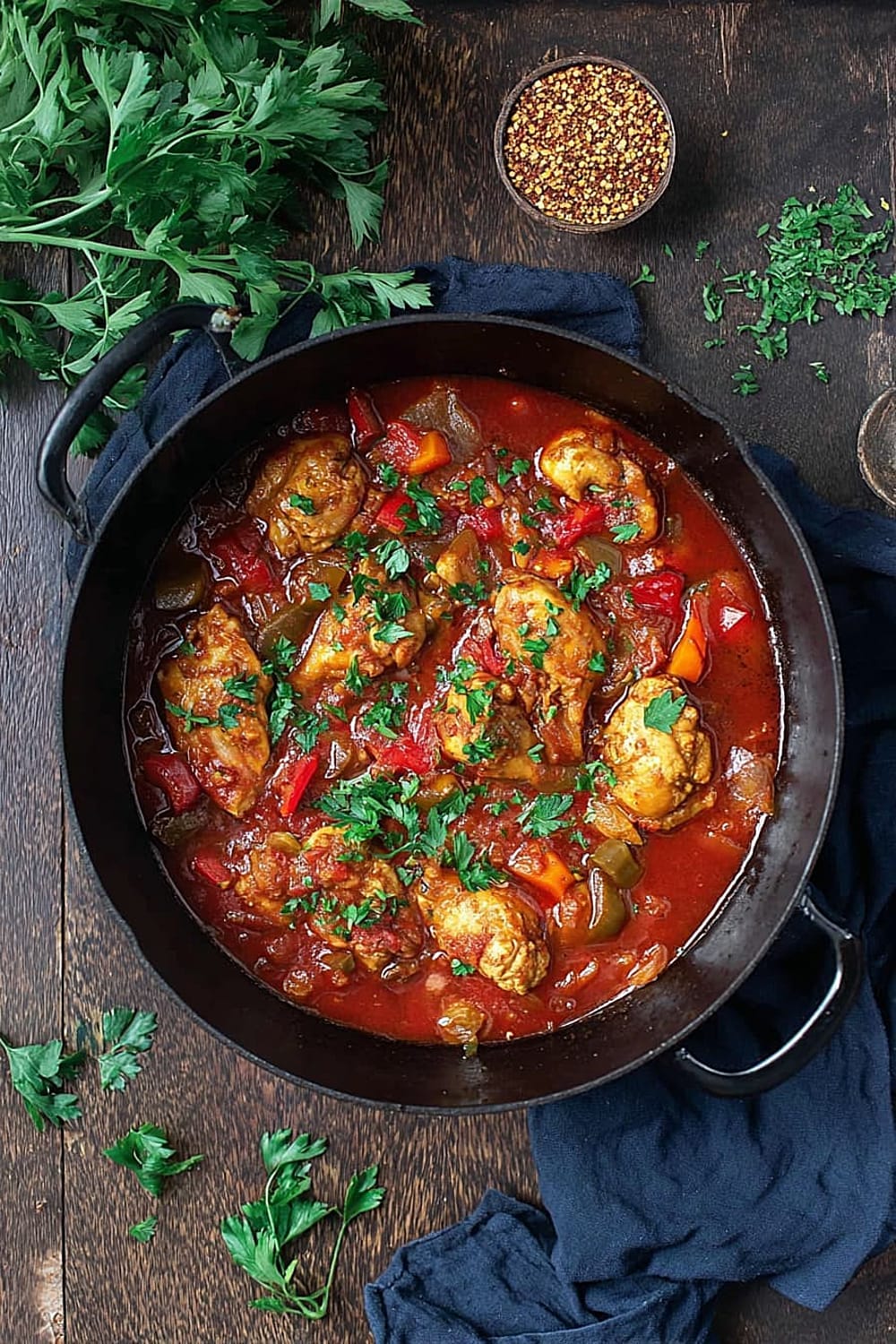
This isn’t your average weeknight stew – it’s a flavor adventure that transforms humble ingredients into something absolutely magical.
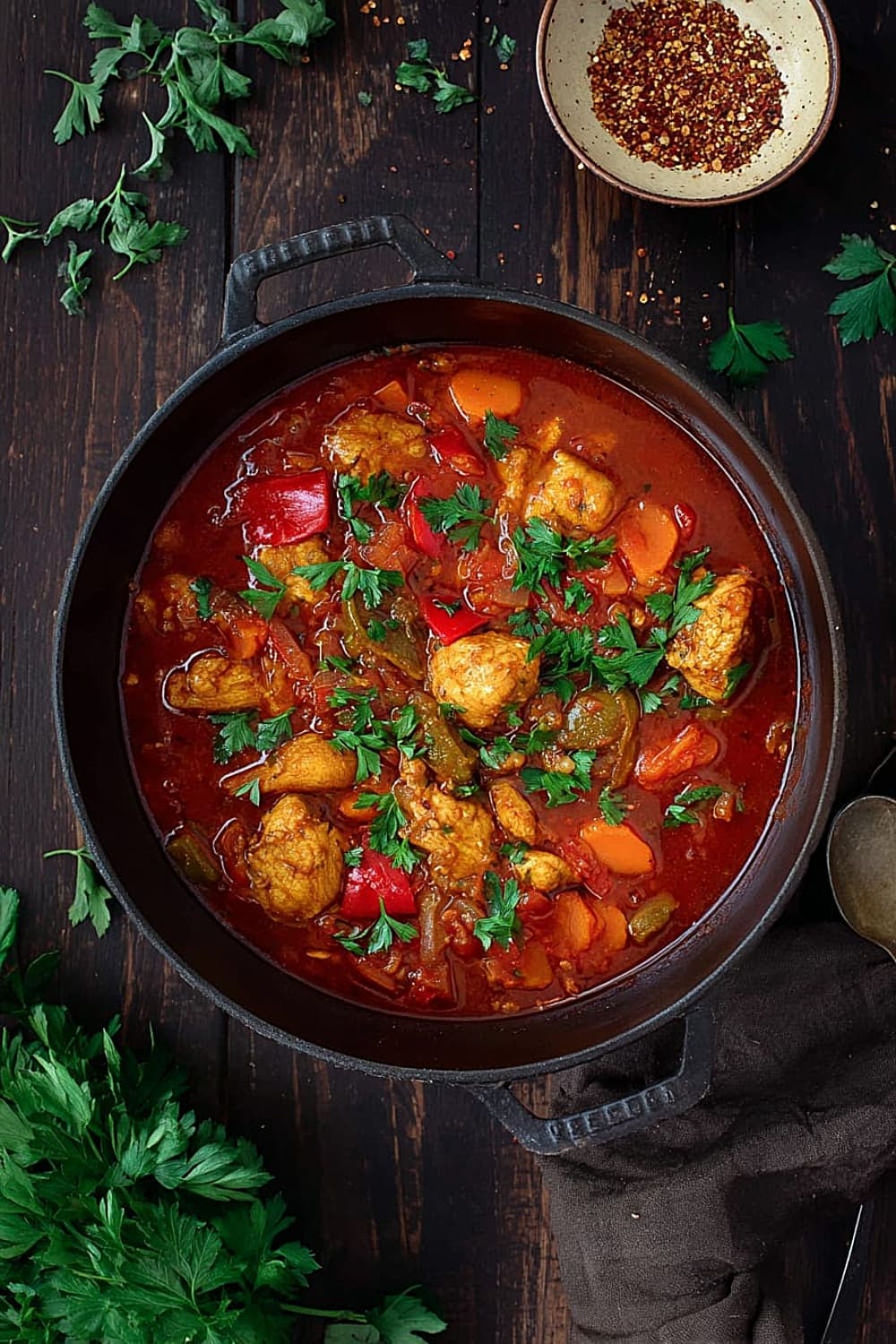
The secret lies in that perfect blend of paprika, coriander, and oregano that creates layers of warmth and complexity in every single bite.

What makes this recipe truly special is how the vegetables break down just enough to thicken the broth naturally, while still maintaining their distinct textures and flavors.
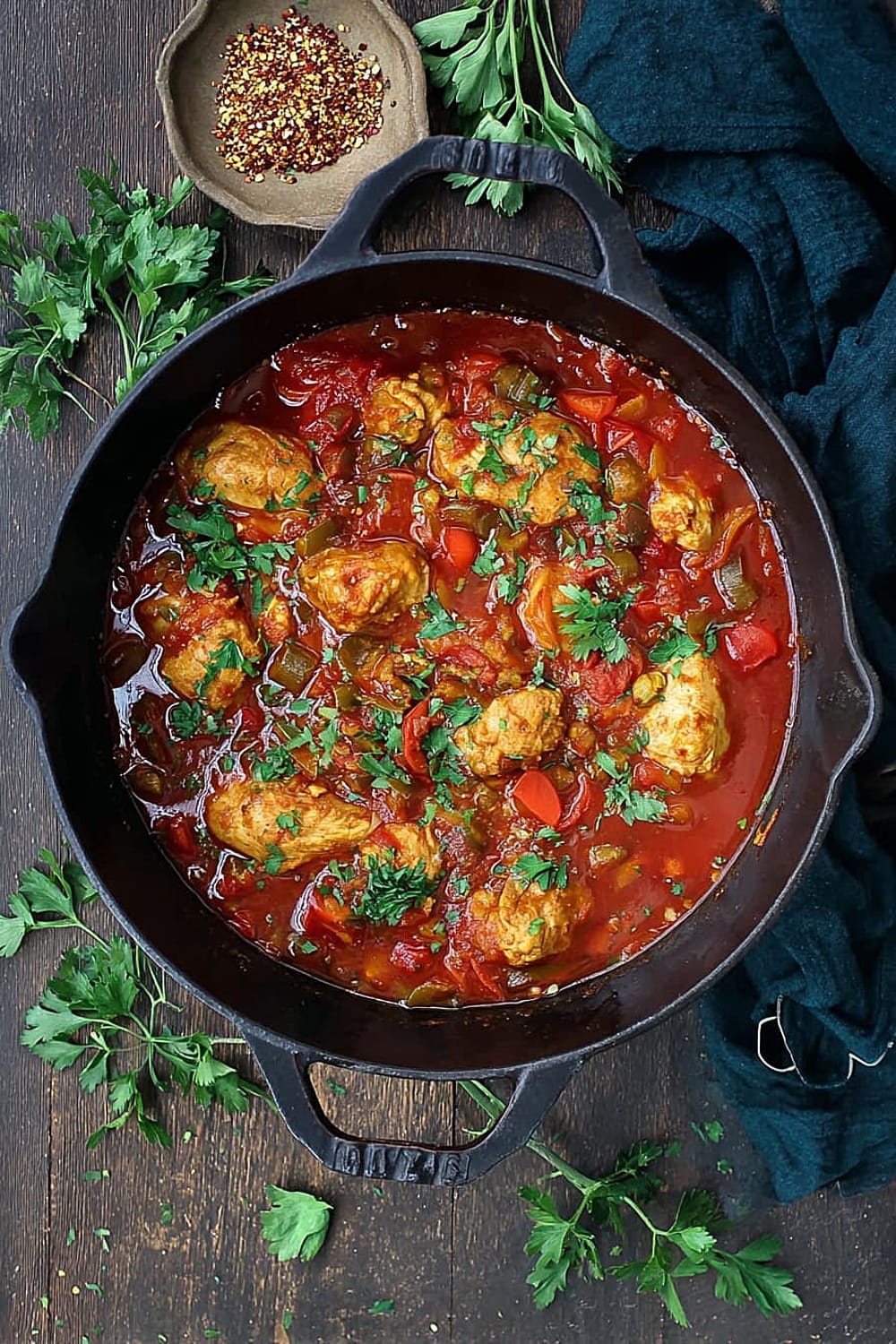
Fair warning: your kitchen is about to smell so incredible that neighbors might start dropping by with suspiciously convenient excuses.
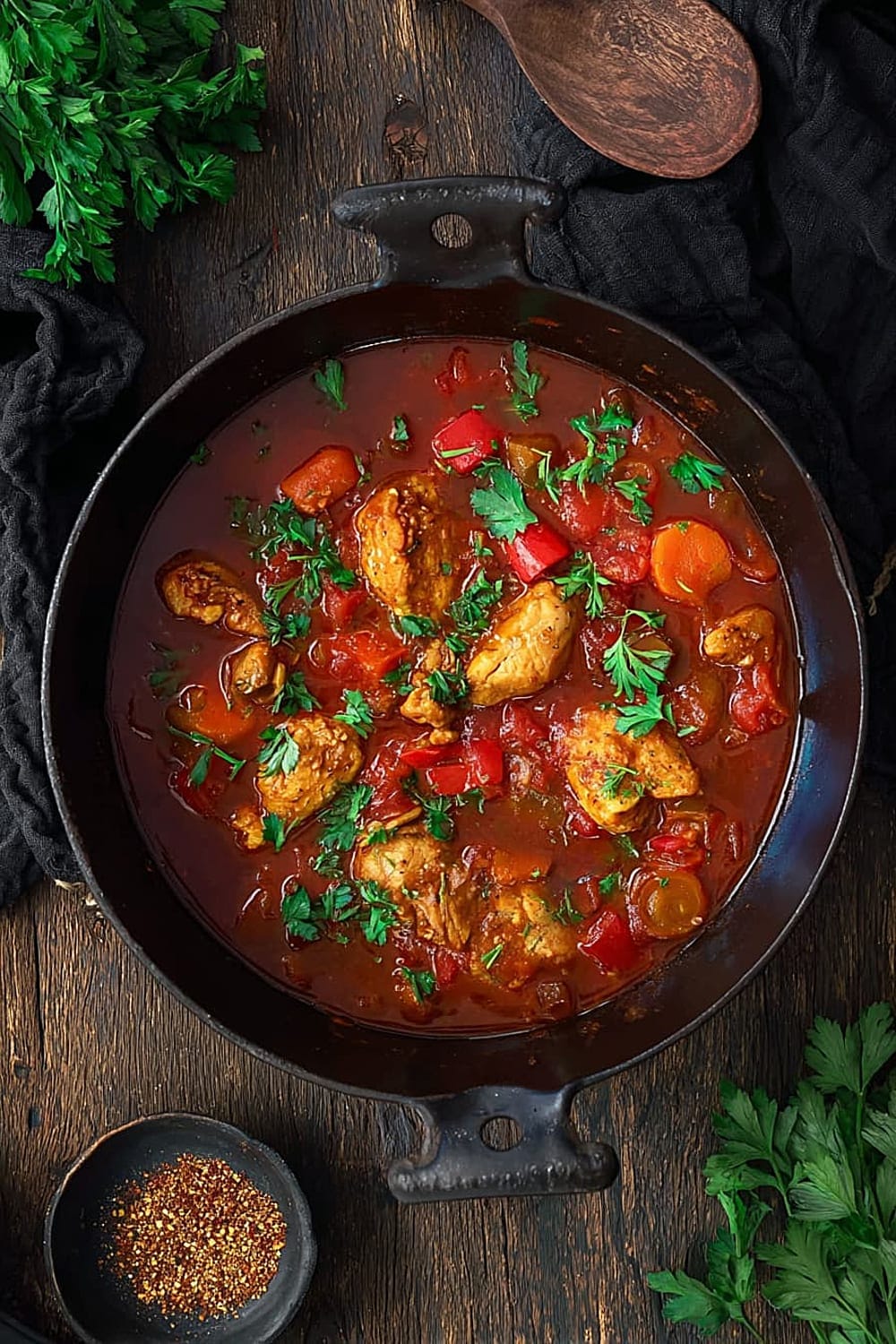
The best part is that while this tastes like you spent hours perfecting ancient culinary arts, it comes together in just one hour with ingredients you probably already have on hand.

Ingredients
For the Chicken
- 1 1/2 pounds boneless skinless chicken thighs (about 8 thighs)
- Kosher salt
- Black pepper
- 2 tablespoons extra virgin olive oil
For the Vegetable Base
- 1 yellow onion, chopped
- 3 garlic cloves, minced
- 2 carrots, peeled and chopped
- 1 red bell pepper, chopped
- 1 zucchini, chopped
- 1 potato, chopped
For the Spice Blend
- 1 teaspoon paprika
- 1 teaspoon coriander
- 1 teaspoon dried oregano
For the Broth
- 1 28-ounce can whole tomatoes (San Marzano preferred)
- 2 cups low sodium chicken broth
- 2 sprigs fresh thyme
- 1 tablespoon white wine vinegar
- 1 cup chopped parsley leaves
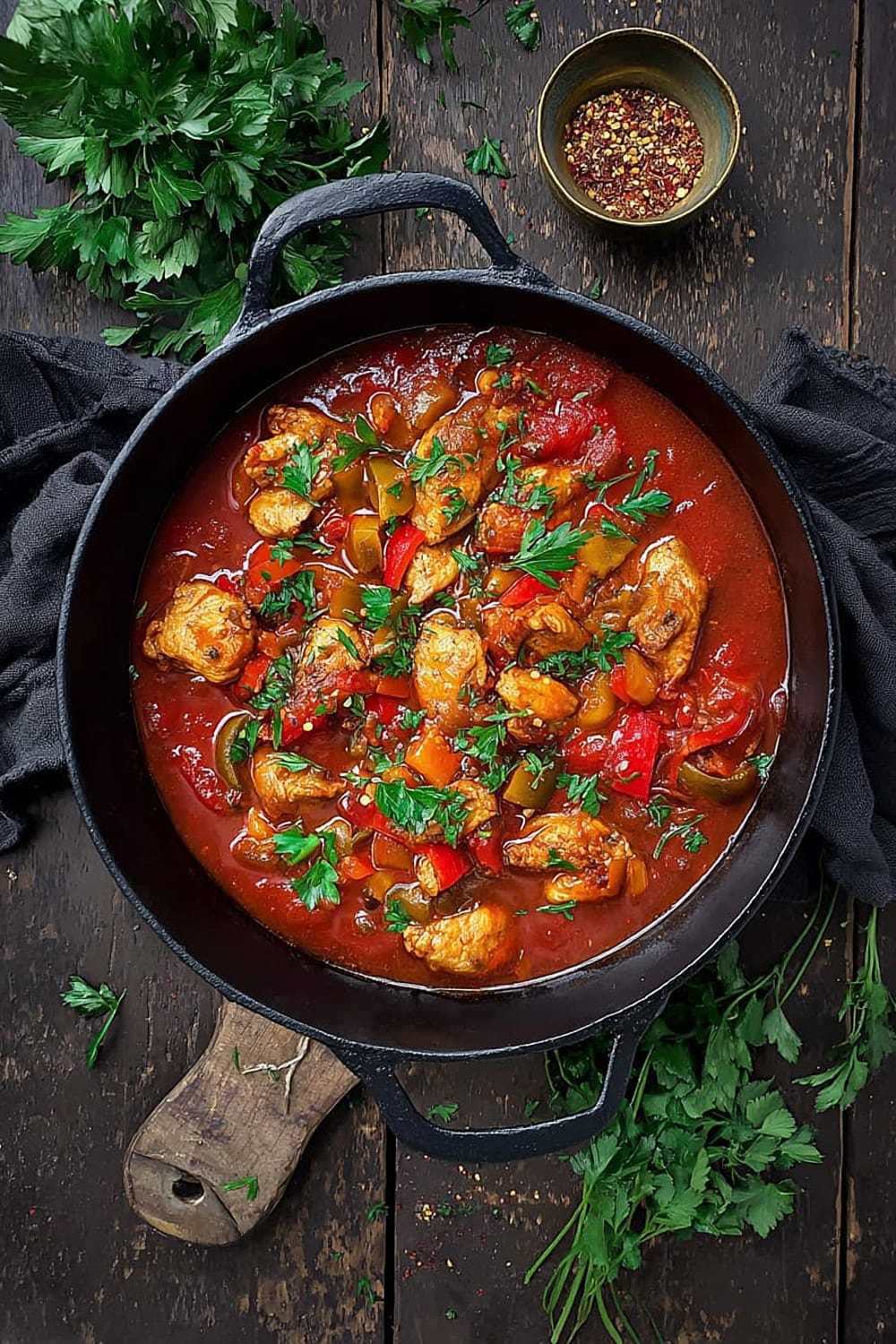
Instructions
Preparation
- 1 Pat the chicken thighs completely dry using paper towels – this is crucial for proper browning. Season one side generously with kosher salt and freshly ground black pepper, pressing the seasoning into the meat.
Brown the Chicken
- 2 Heat a Dutch oven or large heavy-bottomed pot over medium-high heat until hot. Add the 2 tablespoons extra virgin olive oil and heat until shimmering, about 1-2 minutes. The oil should move freely across the pan surface.
- 3 Carefully place the chicken thighs seasoned-side down in the hot oil, ensuring they don’t overlap. You should hear an immediate sizzle – if not, the pan isn’t hot enough. Sprinkle the exposed side with salt and pepper, then cook undisturbed for 4 minutes until deeply golden brown underneath.
- 4 Flip the chicken and cook for an additional 3 minutes until the second side is golden. The internal temperature should reach 165°F (74°C). Transfer chicken to a plate and set aside – it will finish cooking in the stew.
Build the Vegetable Base
- 5 In the same Dutch oven with the rendered chicken fat and oil, add the chopped onion, minced garlic, carrots, red bell pepper, zucchini, and potato. The vegetables should sizzle when they hit the hot surface.
- 6 Season the vegetables with 1 teaspoon paprika, 1 teaspoon coriander, 1 teaspoon dried oregano, and a generous pinch of salt and pepper. Cook, stirring occasionally with a wooden spoon, for 7-8 minutes until the vegetables have softened and developed light charring on the edges.
Create the Stew Base
- 7 Add the 28-ounce can of whole tomatoes, 2 cups low sodium chicken broth, and 2 fresh thyme sprigs to the pot. Use your wooden spoon to break up the tomatoes by pressing them against the bottom of the pot until they burst into chunky pieces.
Simmer and Finish
- 8 Increase heat to high and bring the mixture to a rolling boil, which should take 3-4 minutes. Add the browned chicken thighs back to the pot, nestling them into the liquid.
- 9 Cook on high heat for 5 minutes, stirring occasionally to prevent sticking. The vigorous bubbling helps concentrate flavors and begin breaking down the vegetables.
- 10 Reduce heat to medium-low and partially cover the Dutch oven, leaving about a 1-inch gap for steam to escape. Simmer for 20-30 minutes until the stew has thickened noticeably and the chicken is fork-tender. The liquid should reduce by about one-third.
- 11 Remove from heat and discard the thyme sprigs. Stir in 1 tablespoon white wine vinegar and 1 cup chopped fresh parsley. Taste and adjust seasoning with additional salt and pepper as needed. Serve immediately while hot.

Recommended Equipment and Kitchen Tools
Essential Tools (for best results):
- Dutch oven or heavy-bottomed pot – The thick bottom prevents scorching and provides even heat distribution for perfect browning and simmering. A 5-6 quart capacity works perfectly for this recipe size.
- Wooden spoon – Essential for breaking up tomatoes without scratching your cookware and for stirring without damaging the tender vegetables.
- Sharp chef’s knife – Makes quick work of chopping all those vegetables uniformly, ensuring even cooking throughout the stew.
- Cutting board – A large, stable surface makes vegetable prep safer and more efficient.
Helpful Upgrades:
- Instant-read thermometer – Takes the guesswork out of checking chicken doneness, ensuring food safety while preventing overcooking.
- Kitchen scale – For more precise measurements, especially helpful if you want to batch prep or scale the recipe up for entertaining.
Nice-to-Have Options:
- Immersion blender – If you prefer a partially pureed stew, you can blend just a portion of the vegetables to create a thicker, more rustic texture.
- Microplane grater – Perfect for grating fresh garlic directly into the pot for more intense flavor distribution.

Recipe Variations and Dietary Modifications
Protein Variations:
- Beef chuck roast – Cut into 2-inch chunks, increase cooking time to 45-60 minutes for tender results
- Lamb shoulder – Adds rich, gamey flavor that pairs beautifully with medieval spices
- Turkey thighs – More budget-friendly option with similar cooking time to chicken
- Plant-based protein – Add 2 cups cooked white beans in the last 10 minutes of cooking
Vegetable Swaps:
- Root vegetables – Replace zucchini with parsnips, turnips, or sweet potatoes for earthier flavors
- Seasonal additions – Summer: add fresh corn kernels; Fall: incorporate butternut squash; Winter: use Brussels sprouts
- Mediterranean twist – Add 1/2 cup Kalamata olives and 2 tablespoons capers in the final minutes
Spice Profile Changes:
- Moroccan influence – Replace coriander with 1 teaspoon ground cinnamon and 1/2 teaspoon ground ginger
- Spanish variation – Add 1 teaspoon smoked paprika and a pinch of saffron threads
- Italian adaptation – Include 1 teaspoon dried basil and 1/2 teaspoon red pepper flakes
Texture Modifications:
- Chunky style – Keep vegetables in larger pieces for more rustic presentation
- Smooth base – Blend half the vegetables after cooking for thicker consistency
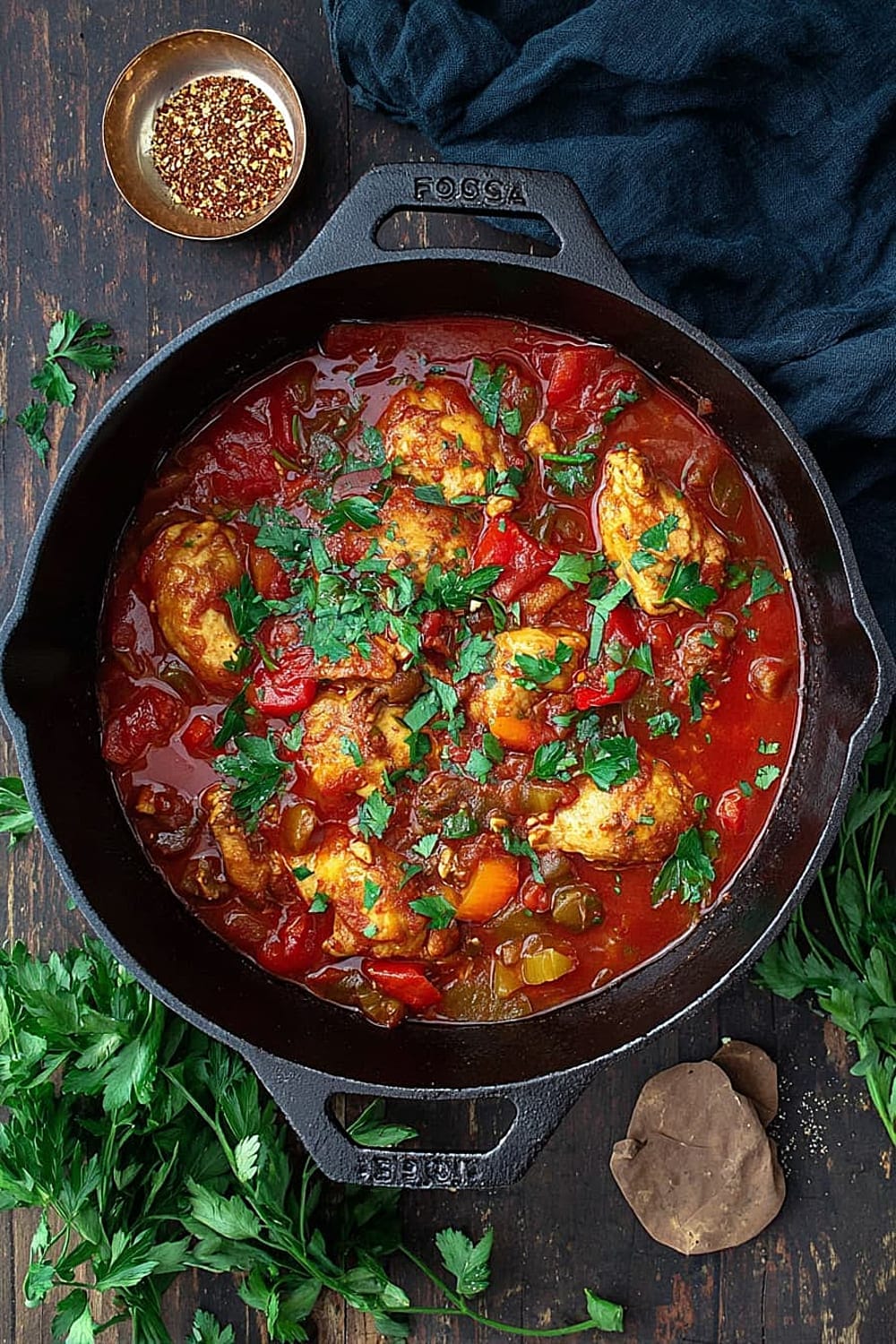
Nutritional Information and Health Benefits
Key Nutritional Highlights:
This hearty stew provides approximately 285 calories per serving, with a balanced macronutrient profile featuring 28g high-quality protein, 12g complex carbohydrates, and 14g healthy fats. The combination of lean chicken thighs and colorful vegetables delivers 6g fiber per serving, supporting digestive health and satiety. The diverse vegetable medley contributes significant amounts of vitamin A from carrots and bell peppers, vitamin C from tomatoes and bell peppers, and potassium from potatoes and zucchini.
Health Benefits of Main Ingredients:
The chicken thighs provide complete protein with all essential amino acids, plus important minerals like selenium and phosphorus for immune function and bone health. Tomatoes are rich in lycopene, a powerful antioxidant that becomes more bioavailable when cooked, potentially supporting heart health and cancer prevention. The paprika and coriander blend offers anti-inflammatory compounds and antioxidants, while garlic provides allicin, known for its antimicrobial and cardiovascular benefits. The olive oil contributes heart-healthy monounsaturated fats and vitamin E.
Dietary Considerations:
This recipe is naturally gluten-free and dairy-free, making it suitable for many dietary restrictions. It’s also low in sodium when using low-sodium broth, and the high protein content makes it appropriate for high-protein diets. The substantial vegetable content aligns with Mediterranean diet principles and provides excellent nutritional density for the calorie content.

Smart Swaps and Ingredient Substitutions
Protein Substitutions:
- Chicken thighs → Chicken breasts (reduce cooking time by 10 minutes to prevent drying)
- Chicken thighs → Pork shoulder cut in chunks (increase simmering time to 40-45 minutes)
- Chicken thighs → Bone-in chicken pieces (add 15 minutes cooking time, remove bones before serving)
Vegetable Alternatives:
- Zucchini → Yellow squash or eggplant (same cooking time)
- Red bell pepper → Orange or yellow bell peppers (identical preparation)
- Potato → Sweet potato or parsnips (may cook slightly faster)
- Carrots → Celery root or rutabaga (chop smaller for even cooking)
Herb and Spice Swaps:
- Fresh thyme → 1 teaspoon dried thyme (add with other dried spices)
- Coriander → Cumin for earthier flavor profile
- Paprika → Smoked paprika for deeper, smokier taste
- Fresh parsley → Fresh cilantro or fresh basil for different flavor notes
Pantry Emergency Substitutions:
- Canned tomatoes → 2 cups tomato sauce plus 1/2 cup water
- Chicken broth → Vegetable broth or water with bouillon cubes
- White wine vinegar → Apple cider vinegar or lemon juice
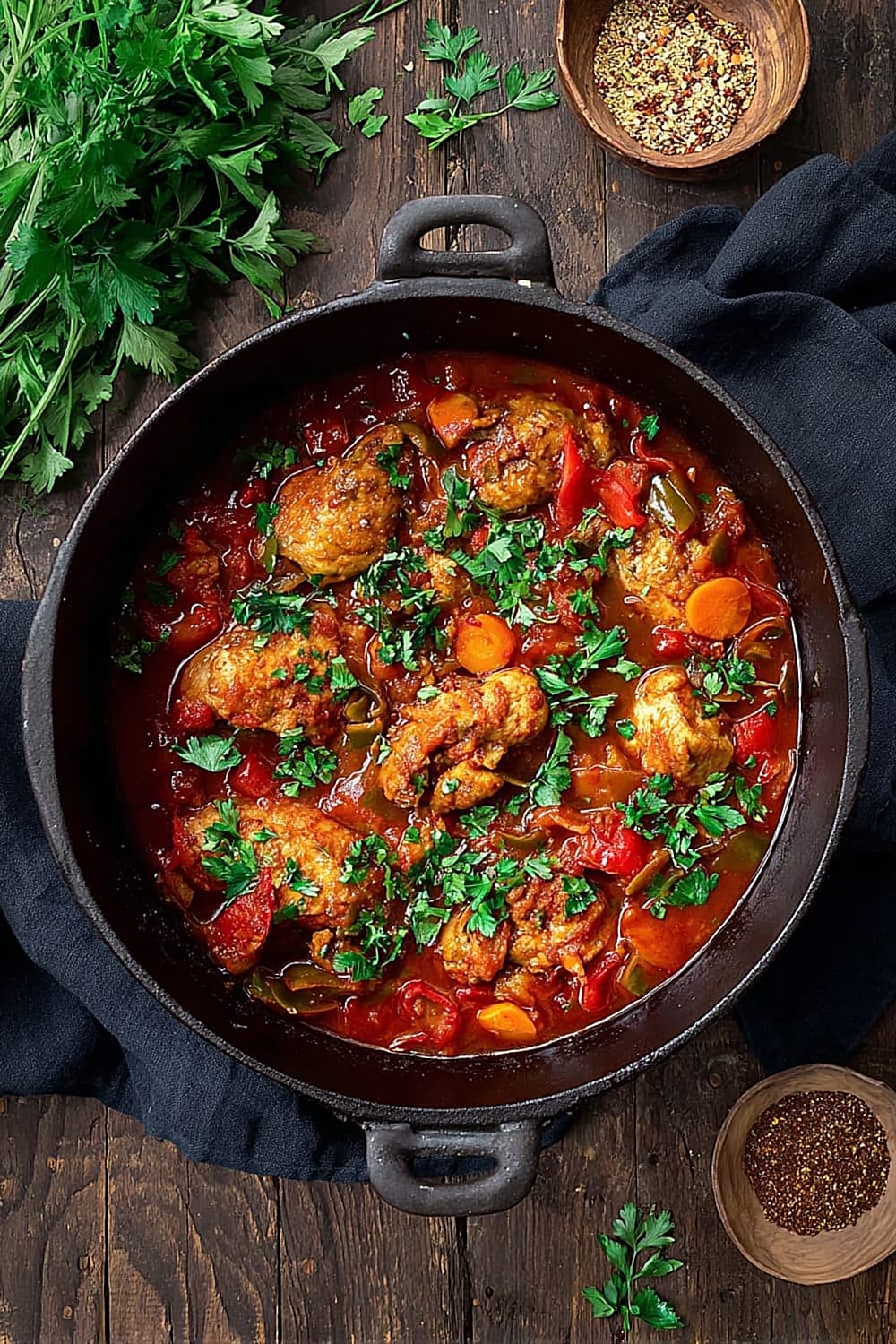
Make It Diabetes-Friendly
Carbohydrate Modifications:
- Replace potato → Use cauliflower florets or radishes to reduce carbs by approximately 15g per serving
- Portion control → Serve 3/4 cup portions instead of full cups to manage carbohydrate intake
- Add extra protein → Include an additional 4 ounces chicken per serving to improve satiety and blood sugar stability
Enhanced Nutritional Profile:
- Increase fiber content → Add 1 cup chopped celery and 1/2 cup diced bell peppers for additional fiber without significant carbs
- Boost healthy fats → Drizzle each serving with 1 teaspoon extra virgin olive oil to slow carbohydrate absorption
- Add non-starchy vegetables → Include 1 cup fresh spinach in the last 2 minutes of cooking
Blood Sugar Management Tips:
- Pair with protein → Serve alongside Greek yogurt or cottage cheese for additional protein
- Timing considerations → This stew works well for lunch when paired with a small salad
- Portion awareness → Each modified serving contains approximately 18g total carbohydrates and 8g fiber
Total Carb Reduction: Modified version reduces carbohydrates from 25g to 18g per serving while maintaining flavor and satisfaction.
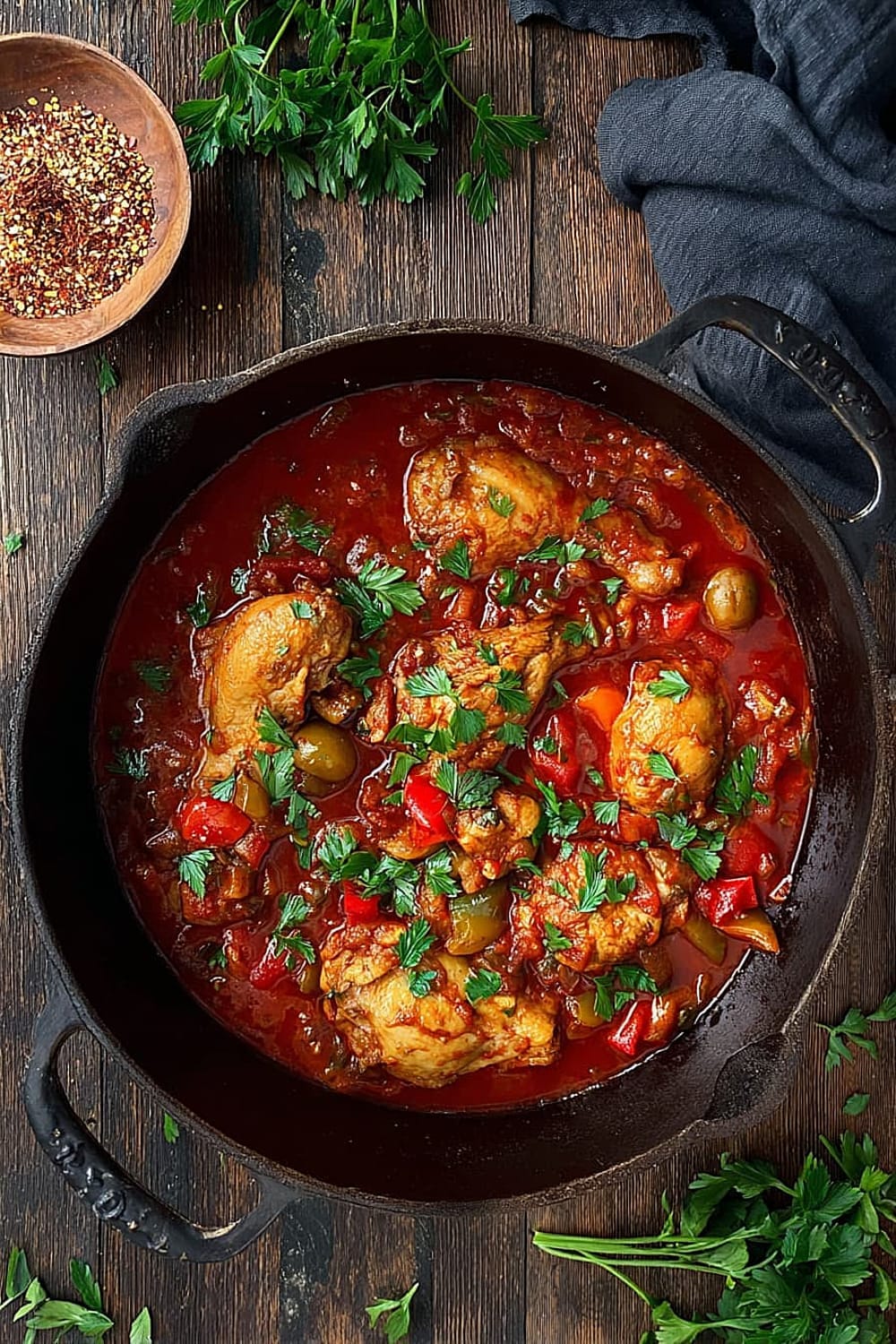
Perfect Pairing Suggestions
Beverage Pairings:
This robust stew pairs beautifully with medium-bodied red wines like Côtes du Rhône or Chianti, whose earthy notes complement the medieval spice blend perfectly. For beer lovers, try a Belgian dubbel or brown ale that won’t compete with the complex flavors. Non-alcoholic options include sparkling water with lemon or herbal teas like chamomile or mint to cleanse the palate between bites.
Side Dish Recommendations:
Serve with crusty artisan bread or warm pita for sopping up every drop of that incredible broth. Creamy polenta makes an elegant base that absorbs the stew’s flavors beautifully. For lighter options, try simple arugula salad with lemon vinaigrette or roasted Brussels sprouts with garlic. Wild rice pilaf or herb-roasted potatoes add heartiness for larger appetites.
Complete Meal Ideas:
Start with Mediterranean olives and aged cheese as appetizers, then follow the stew with honey-drizzled Greek yogurt topped with chopped pistachios for dessert. For casual entertaining, serve family-style with mixed greens, warm bread, and seasonal fruit for a complete, satisfying meal.
Occasion Suggestions:
This stew shines at intimate dinner parties, cozy weekend meals, and holiday gatherings when you want something special but not fussy. It’s perfect for meal prep Sundays and potluck contributions since it travels well and tastes even better the next day.

Pro Tips and Troubleshooting
Professional Techniques:
Always pat chicken completely dry before seasoning – moisture prevents proper browning and creates steam instead of that crucial caramelized crust. Don’t overcrowd the pot when browning; work in batches if necessary to maintain high heat. The key to deep flavor development is patience during the vegetable sautéing phase – let them get those golden edges for maximum taste impact.
Common Mistake Prevention:
Avoid lifting the lid too frequently during simmering, which releases steam and extends cooking time. If your stew seems too thin, remove the lid completely for the last 10 minutes to encourage evaporation. Conversely, if it’s reducing too quickly, add warm broth 1/4 cup at a time to maintain proper consistency.
Storage and Reheating:
This stew keeps beautifully in the refrigerator for 4-5 days and actually improves in flavor as the spices meld. Reheat gently on the stovetop over medium-low heat, adding a splash of broth if needed. For freezing, cool completely and store in portions for up to 3 months – just thaw overnight before reheating.
Make-Ahead Strategy:
Prepare through step 6, then refrigerate the vegetable base overnight. The next day, simply add liquids, bring to a boil, and continue with the recipe. This actually enhances flavor development and makes entertaining effortless.
Presentation Tips:
Serve in warmed bowls with a sprinkle of fresh herbs and a drizzle of good olive oil for restaurant-quality presentation that showcases this medieval-inspired masterpiece.

The beauty of this Medieval Spiced Chicken Stew lies in its perfect balance of comfort and sophistication – it’s the kind of recipe that makes any dinner feel like a special occasion. Whether you’re cooking for family or entertaining guests, this aromatic, soul-warming stew delivers layers of flavor that will have everyone asking for seconds and the recipe.